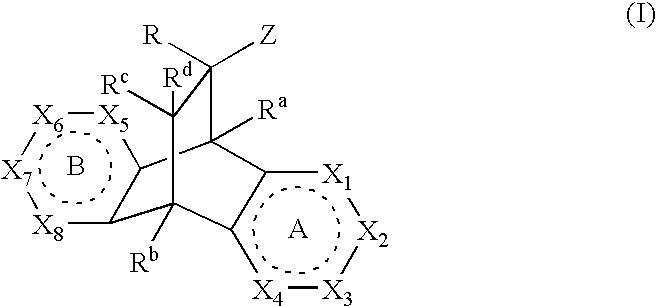Modulators of the glucocorticoid receptor, AP-1, and/or NF-kappaB activity and use thereof
a technology of glucocorticoid receptor and ap-1, which is applied in the field of new nonsteroidal compounds, can solve the problems of limited systemic use of glucocorticoid receptor modulators
- Summary
- Abstract
- Description
- Claims
- Application Information
AI Technical Summary
Problems solved by technology
Method used
Image
Examples
preparation 1
[0320]
Step 1
[0321] To a dioxane (18 mL) solution of 1-(4-fluoro-naphthalen-1-yl)ethanone (5.4 g, 28.69 mmol) at 0° C. was added bromine (5.61 g, 35.13 mmol). After 3 hours at room temperature the reaction mixture was concentrated in vacuo to give the crude bromide (7.66 g).
Step 2
[0322] To a solution of the product of step 1 (7.66 g, 28.69 mmol) in ethyl alcohol (20 mL) at room temperature was added thiourea (2.75 g, 36.13 mmol). After 1 hour at room temperature a precipitate formed. The reaction mixture was diluted with water (100 mL) and filtered. The solid was then washed with water (3×100 mL) and dichloromethane (3×100 mL). The pure aminothiozole was obtained after drying in vacuo (5.5 g, 75%). MS Found: (M+H)+=245.
preparation 2
[0323]
Step 1
[0324] To a CHCl3 (94 mL) and EtOAc (188 mL) solution of 1-acetonaphthone (30 g, 0.176 mol) was added copper (II) bromide (78.7 g, 2 eq). The suspension was heated to reflux for 17.5 h and filtered. The filtrate was washed with water until pH of 7 (6×500 mL), dried over MgSO4 and concentrated to give a brown liquid as the crude bromide product (42.6 g, ˜80% pure).
Step 2
[0325] To a DMF (200 mL) solution of N-acetylguinadine (34.5 g, 2 eq) was added dropwise a DMF (100 mL) solution of the crude product of Step 1 (42.6 g, 0.17 mol) at 0° C. After 2 h at 0° C., the ice-bath was removed and the mixture was stirred at room temperature overnight. The reaction mixture was then diluted with water (500 mL) and extracted with CH2Cl2. The organic phase was dried over MgSO4 and concentrated to give a dark solid (36 g). This solid was triturated with 30% EtOAc-hexanes to give a gray solid as pure product (9.53 g, 21.5% for two steps). The rest of the solution still contains produ...
preparation 3
[0327]
[0328] Benzo[g]quinoxaline (1 g, 5.55 mmol, prepared according to a literature procedure: Synthesis, 1982, 61), methacrylic acid (10 mL) and 1,4-dihydroquinone (61 mg, 0.1 eq) was mixed in a sealed tube and heated at 180° C. for 25.5 h. The mixture was isolated first by flash column chromatography (50% ethyl acetate-hexanes). The two isomers were separated by preparative reverse-phase HPLC, using YMC S5 ODS 30×250 mm column and linear gradient of 70% to 100% solvent B (solvent A 10% MeOH / 90% water / 0.1% TFA, solvent B 90% MeOH / 10% water / 0.1% TFA), to give isomer A (259 mg, 18%) and isomer B (179 mg, 12%). MS Found: (M+H)+=267.
PUM
| Property | Measurement | Unit |
|---|---|---|
| temperatures | aaaaa | aaaaa |
| temperature | aaaaa | aaaaa |
| pH | aaaaa | aaaaa |
Abstract
Description
Claims
Application Information
 Login to View More
Login to View More - R&D
- Intellectual Property
- Life Sciences
- Materials
- Tech Scout
- Unparalleled Data Quality
- Higher Quality Content
- 60% Fewer Hallucinations
Browse by: Latest US Patents, China's latest patents, Technical Efficacy Thesaurus, Application Domain, Technology Topic, Popular Technical Reports.
© 2025 PatSnap. All rights reserved.Legal|Privacy policy|Modern Slavery Act Transparency Statement|Sitemap|About US| Contact US: help@patsnap.com



